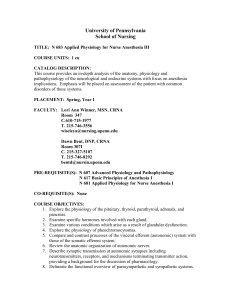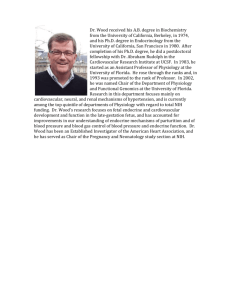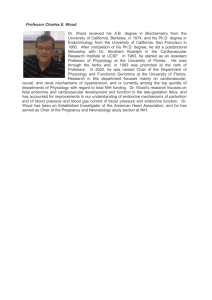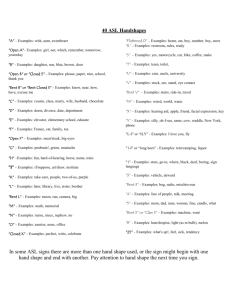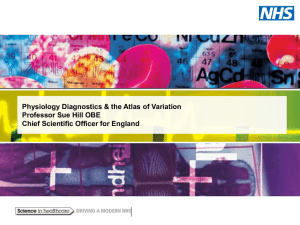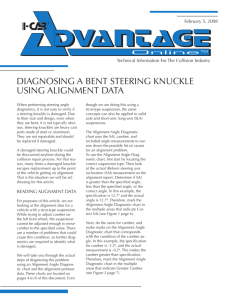N683 Applied Physiology for Nurse Anesthesia III
advertisement
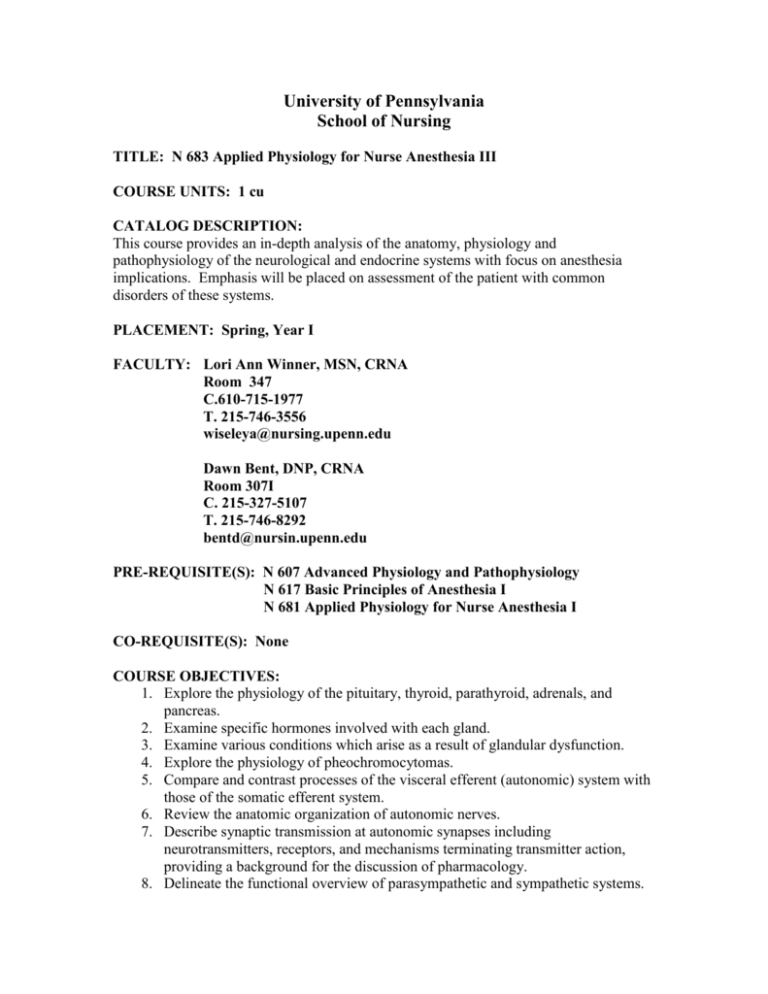
University of Pennsylvania School of Nursing TITLE: N 683 Applied Physiology for Nurse Anesthesia III COURSE UNITS: 1 cu CATALOG DESCRIPTION: This course provides an in-depth analysis of the anatomy, physiology and pathophysiology of the neurological and endocrine systems with focus on anesthesia implications. Emphasis will be placed on assessment of the patient with common disorders of these systems. PLACEMENT: Spring, Year I FACULTY: Lori Ann Winner, MSN, CRNA Room 347 C.610-715-1977 T. 215-746-3556 wiseleya@nursing.upenn.edu Dawn Bent, DNP, CRNA Room 307I C. 215-327-5107 T. 215-746-8292 bentd@nursin.upenn.edu PRE-REQUISITE(S): N 607 Advanced Physiology and Pathophysiology N 617 Basic Principles of Anesthesia I N 681 Applied Physiology for Nurse Anesthesia I CO-REQUISITE(S): None COURSE OBJECTIVES: 1. Explore the physiology of the pituitary, thyroid, parathyroid, adrenals, and pancreas. 2. Examine specific hormones involved with each gland. 3. Examine various conditions which arise as a result of glandular dysfunction. 4. Explore the physiology of pheochromocytomas. 5. Compare and contrast processes of the visceral efferent (autonomic) system with those of the somatic efferent system. 6. Review the anatomic organization of autonomic nerves. 7. Describe synaptic transmission at autonomic synapses including neurotransmitters, receptors, and mechanisms terminating transmitter action, providing a background for the discussion of pharmacology. 8. Delineate the functional overview of parasympathetic and sympathetic systems. 2 9. Describe autonomic reflexes and higher centers regulating and coordinating autonomic outflow. 10. Describe basic neuro-anatomy and neurophysiology and its importance to the safe practice of administration and management of anesthesia. 11. Examine gross anatomy of the nervous system, synaptic transmission, neurotransmission within the brain, and neuro receptors. 12. Discuss principles of sensory function with regard to somatic sensory and motor function, proprioception, and pain pathways. 13. Explore the function of cranial nerves. 14. Discuss production, and circulation of CSF, cranial vault theory, intracranial TEACHING METHODS: Lecture, discussion, case studies, and cadaver lab sessions EVALUATION METHODS: Exam #1 40% Exam #2 20% Exam#3 30% Cadaver Diagrams 10% GRADING POLICY: A+ 97-100 B+ 87-89 A 93-96 B 83-86 A- 90-92 B- 80-82 C+ 77-79 C 73-76 C- 70-72 F 0-69 Rounding will be done as follows: Grades of .5 and above will be rounded up to the next whole number Grades of .4 or less will be rounded down to the next whole number Code of Academic Integrity Since the University is an academic community, its fundamental purpose is the pursuit of knowledge. Essential to the success of this educational mission is a commitment to the principles of academic integrity. Every member of the University community is responsible for upholding the highest standards of honesty at all times. Students, as members of the community, are also responsible for adhering to the principles and spirit of the following Code of Academic Integrity. Academic Dishonesty Definitions Activities,that have the effect or intention of interfering with education, pursuit of knowledge, or fair evaluation of a student’s performance are prohibited. Examples of such activities include but are not limited to the following definitions: A. Cheating: using or attempting to use unauthorized assistance, material, or study aids in examinations or other academic work or preventing, or attempting to prevent, another from using authorized assistance, material, or study aids. 3 Example: using a cheat sheet in a quiz or exam, altering a graded exam and resubmitting it for a better grade, etc. B. Plagiarism: using the ideas, data, or language of another without specific or proper acknowledgment. Example: copying another person’s paper, article, or computer work and submitting it for an assignment, cloning someone else’s ideas without attribution, failing to use quotation marks where appropriate, etc. C. Fabrication: submitting contrived or altered information in any academic exercise. Example: making up data for an experiment, fudging data, citing nonexistent articles, contriving sources, etc. D. Multiple submission: submitting, without prior permission, any work submitted to fulfill another academic requirement. E. Misrepresentation of academic records: misrepresenting or tampering with or attempting to tamper with any portion of a student’s transcripts or academic record, either before or after coming to the University of Pennsylvania. Example: forging a change of grade slip, tampering with computer records, falsifying academic information on one’s resume, etc. F. Facilitating academic dishonesty: knowingly helping or attempting to help another violate any provision of the Code. Example: working together on a takehome exam, etc. G. Unfair advantage: attempting to gain unauthorized advantage over fellow students in an academic exercise. Example: gaining or providing unauthorized access to examination materials, obstructing or interfering with another student’s efforts in an academic exercise, lying about a need for an extension for an exam or paper, continuing to write even when time is up during an exam, destroying or keeping library materials for one’s own use., etc. * If a student is unsure whether his action(s) constitute a violation of the Code of Academic Integrity, then it is that student’s responsibility to consult with the instructor to clarify any ambiguities. http://www.vpul.upenn.edu/osl/pennbook.html REQUIRED TEXTS: Rhoades, R.A. & Bell, D.R. (2009). Medical Physiology: Principles for Clinical Medicine 3rd Edition. Philadelphia: Lippincott, Williams, & Wilkins. Morgan, E.G., Mikhail, M. S., & Murray, M.J. (2006). Clinical Anesthesiology 4th Ed. New York: Lange Medical Division/McGraw-Hill Companies, Inc. Stoelting, R. & Miller, R. (2007). Basics of Anesthesia 5th Edition. New York: Churchill Livingstone. Nagelhout, J. & Zaglaniczny (2007). Nurse Anesthesia 4th Edition. Missouri: Elsevier Saunders. 4 RECOMMENDED TEXTS: Lilly, L.S. (2003). Pathophysiology of Heart Disease: A collaborative project of medical students and faculty. 3rd Ed. Philadelphia: Lippincott, Williams, & Wilkins. Barash, P.G., Cullen, B.F. & Stoeling, R.K. Eds. (2000). Clinical Anesthesia 4th Edition. Phila., PA: Lippincott, Williams & Wilkins. McPhee, S.J., Lingappa, V.R., Ganong, W.F., Lange, J.D. Pathophysiology of Disease: An Introduction to Clinical Medicine, 6th Ed., New York, Lange Medical Books/McGraw-Hill, 2006. ISBN: 007144159X. Fleischer, L. (2009). Evidenced Based Practice of Anesthesiology. 2nd Edition. Philadelphia: W.B. Saunders, Co. Netter, F.H., & Hanson, J.T. (2010). Atlas of Human Anatomy. 5th Edition. Missouri: Elsevier Saunders. Guyton, A. & Hall, J. (2006). Textbook of Medical Physiology 11th Ed. Philadelphia: W. B. Saunders, Co. 5 CLASSES HELD MONDAYS Date/Time Topic 1PM-4PM FAGIN HALL Objective Readings Week 1 January 14, 2013 L. Winner Neurophysiology 9-4p Neurophysiology Week 2 January 21, 2013 Organization, structure of nervous system, and transmission MLK DAY NO CLASS Week 3 January 28, 2013 L. Winner Week 4 February 4, 2013 4-14 R&B Ch 7 M&M Ch. 25 S& M Ch 30 N&P Ch 29 NO CLASS!!!! 4-14 R&B Ch 4,5,6,&8 N&P Ch 13, 14, 29, & 33 Neurophysiology 4-14 R&B Ch 6 N&P Ch 13, 14, 29, & 33 Central Nervous System Autonomic Nervous System L. Winner Week 5 February 11, 2013 L. Winner Week 6 February 18, 2013 Winner & Bent Week 7 February 25, 2013 D. Bent M&M pgs. 205-208, 227-231, 237-239, 242-246, & 359-372. S&M Ch 7 & 12 Information from weeks 1-4. Exam #1 Neurophysiology Cadaver Lab #1: Identification and observation of structures within the Dorsal Body Cavity: CNS and spine, Upper & Lower Extremity **Scrubs required for your admittance to Lab 2:30-4:00 10 & 11 Endocrine: The Pancreas 1-3 Review structures: Muscles, Nerves, Vessels located within the dorsal body cavity 1. Shoulder & Upper extremity 2. Neck anatomy 3. Hip & Lower extremity CNS (brain & spinal cord, vertebral canal) R&B: Ch 34 pp 641-655 6 Week 8 March 4, 2013 SPRING BREAK NO CLASS Week 9 March 11, 2013 D Bent Week 10 March 18, 2013 D Bent Week 11 March 25, 2013 D Bent Week 12 April 1, 2013 D. Bent Week 13 April 8, 2013 Endocrine: The Adrenal Glands D. Bent Week 14 April 15, 2013 Winner & Bent 1-4 Exam #2 Endocrine R&B: Ch 33, pp. 624-640 NAG: Ch34, pp. 823-834 Information from weeks 7&9. Endocrine: The Thyroid & Parathyroid Glands 1-3 R&B: CH 32, pp 612-623 NAG: Ch 34 pp 834-8, 809-13 Endocrine: The Pituitary & Hypothalamus 1-3 R&B: Ch 31, pp. 596-611 NAG: Ch 34 pp. 802-809 Endocrine Case Studies Anesthetic implications associated with: Acromegaly, SIADH, Inadequate secretion of ADH, Hypoparathyroidism, Diabetes, Primary aldosteronism, Cushing’s Syndrome, Addison’s Disease, Pheochromocytoma, Hyperthyroidism, & Hypothyroidism Cadaver Lab #2: Identification and observation of Structures within the Ventral Body Cavity Thorax, Abdomen, and Pelvis **Scrubs required for your admittance to the lab 2:30-4:00 1-4 NAG Ch 34 pp 802-841 M&M: Ch 36, pp. 802-816 Week 15 April 22, 2013 Exam #3 Endocrine Week 16 April 24-26, 2013 Week 17 April 29-May 7, 2013 Reading Days Final Exams TOTAL NUMBER OF THEORY HOURS: 45 TOTAL NUMBER OF CLINICAL HOURS: 0 Review structures Muscles, Nerves, Vessels located within the ventral body cavity: 1. Neck, Heart, Lungs 2. Abdominal cavity Pelvic/Urogenital structures (including pelvic floor) Information from weeks 11, 12, & 14.
